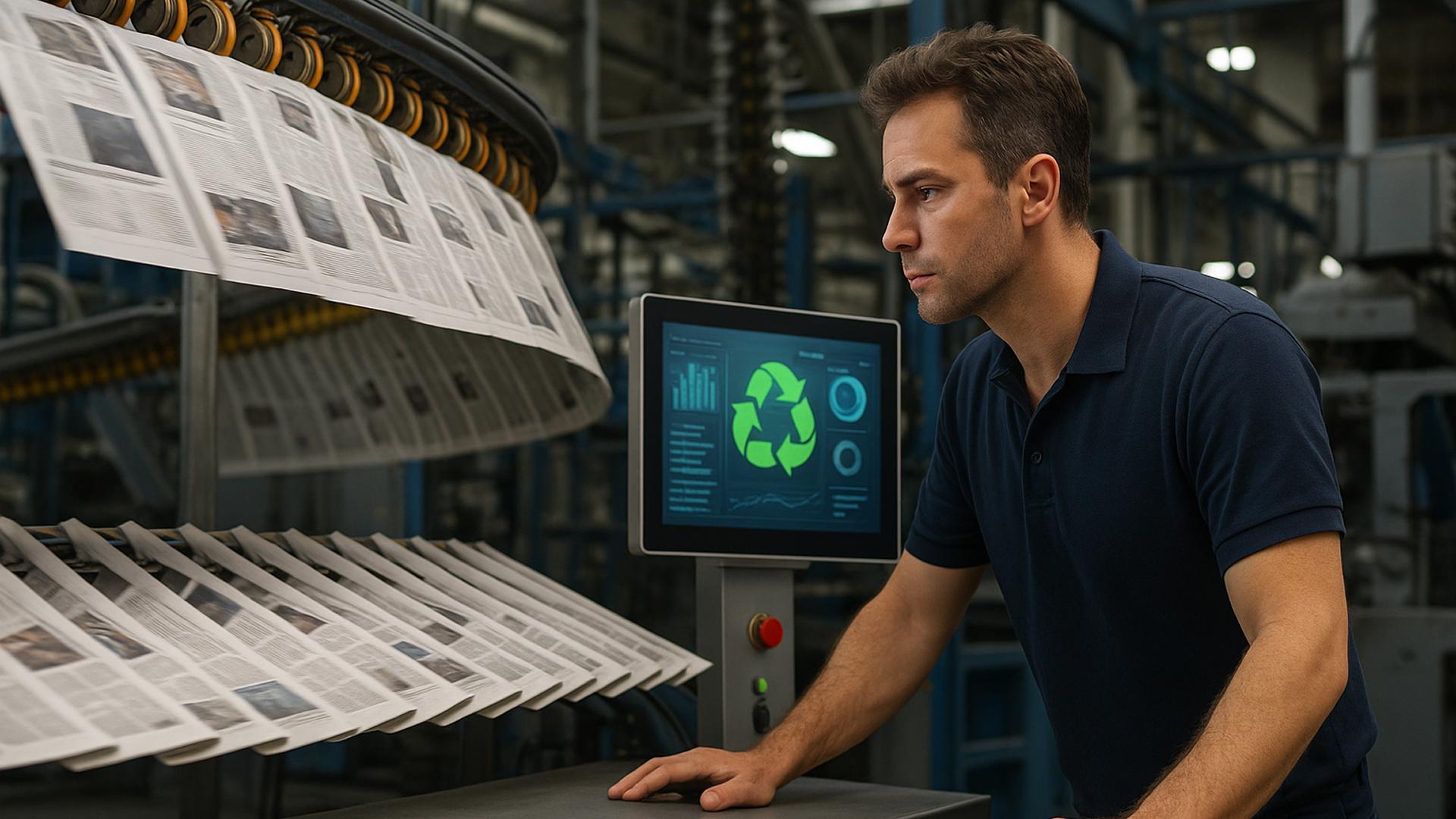Blogs
AI
Internet of Things
Reducing Publishing Print Wastage through Industry 4.0
By Muhammed Abdulla NC | Published on Sep 25 | 5 Minute Read

Want to reduce print waste and redefine your business but are not sure where to begin?
Here’s how you can opt for sustainability print with Industry 4.0: a game-changer in print waste reduction!
While printing is undoubtedly necessary for any business, it often ends up being an unnecessary expense, which not only reduces profits but also causes adverse environmental impacts. Waste has been an inevitable component of the printing industry. Environmental Protection Agency (EPA) statistics show that paper makes up 25% of landfill waste in the United States alone, with annual paper waste reaching up to 11 million metric tons. To reduce print waste and improve sustainability, many businesses and companies are opting for Industry 4.0: an absolute game-changer in waste reduction!
This article will describe in detail how Industry 4.0, with the help of smart printers and sustainable practices, can help save money and the environmental impact of waste reduction.
Advanced Technologies for Print Efficiency
Printing efficiency is soaring to great heights with modern innovations and advanced technologies, helping companies reduce waste and enhance sustainability. Incorporating the Internet of Things (IoT) is one of the most vital developments, enabling you to keep track of materials, guarantee uniformity across all aspects of operation, observe production procedures in real-time, et al.
Typically, IoT-enabled printers are a system of interconnected gadgets that help notify management when specific criteria are reached or surpassed (for instance, when trash reaches a specific level or a time restriction has passed).
Another option that you can consider to improve the efficiency of your printing operations is big data and analytics in print management. As a business, you might spot patterns in consumption that may point to opportunities for cost savings or areas for improvement—by analyzing customer data and monitoring trends in print jobs. Consequently, you can utilize predictive analytics to foresee client demand and modify output as necessary.
By allowing businesses to produce projects as needed, print-on-demand technology has also made it effortless to meet client requests. With this technology, you can manufacture orders with little setup time and without keeping tons of inventory on hand. Besides, web-to-print solutions also make it simple and quick for clients to place orders online while offering owners more control over their orders.
What’s more, smart printers and sustainable materials come equipped with energy-saving technologies like automated toner management systems, which help you complete projects with maximum quality and efficacy. Thus, by switching from conventional petroleum-based supplies to sustainable ones like recycled paper and soy-based inks, you can potentially lessen the drastic impact of waste on the environment!
Waste Reduction Strategies
With many businesses prominently benefiting from Industry 4.0 print waste technologies, the printing sector is swiftly making the much-needed switch. Reduced overproduction of waste can help boost sustainability while maximizing the efficiency of digital printing solutions, which is always a financial reward.
Thus, you must opt for energy-efficient and sustainable printers to effectively streamline operations and generate products with little waste, especially those with eco-friendly inks and toner management techniques. This helps you cut down on energy usage without losing print quality or speed, directly impacting the growth of your business.
Besides, if you want to save a tad bit more while simultaneously developing an environment-friendly printing process, you need to adopt digital printing techniques right away! These solutions offer personalized content based on consumer behavior, which removes manual labor or material expenditures required for finishing operations.
They also help organizations achieve sustainability goals and identify any possible problems even before they arise. Therefore, you can cut costs while enhancing workplace sustainability initiatives by investing in Industry 4.0 print waste technology.
Supply Chain Optimization
To optimize the supply chain and reduce waste, the printing sector is quickly catching up with Industry 4.0 technologies, and as a business, you should also tag along! Needless to say, by adopting an Industry 4.0 print waste solution, you can cut costs, boost productivity—and encourage a more environment-friendly printing process.
Further, you can identify possible issue areas in your inventory management and supply chain through a thorough review. This basically entails analyzing each stage—from the choice of the source material to the delivery of the output—and identifying any areas for optimization or improvement.
You may track how all of your tasks are progressing through production by using radio-frequency identification (RFID) tags. The RFID tags are affixed to materials used in manufacturing, enabling you to monitor which components are being used at each stage—as well as to calculate production times and efficiently manage inventory levels precisely. Besides, real-time tracking solutions add another level of visibility to operations so you can always have the most recent knowledge about individual orders.
Implementing Just-in-Time (JIT) printing solutions can also help you fulfill client demands quickly and effectively—by allowing them to manufacture projects in response to demand rather than overproducing things that might not be sold or needed right away. As a result, implementing Industry 4.0 can improve performance management while eliminating excessive waste.
Sustainability and Environmental Impact
With the help of IoT and other Industry 4.0 technologies, you can reduce waste and boost productivity—directly allowing sustainability and environmental impact. Industry 4.0 print waste solutions have the potential to not only reduce carbon footprints but also maximize output and save energy and resources.
By reusing and recycling print materials, you can avoid extracting virgin elements, preventing more pollution and waste. Interestingly, you contribute to massive energy savings and minimize the environmental impact of waste reduction. And even better, reusing and recycling print content is an efficient and cost-effective way that benefits your business as well as the environment!
Conclusion
Although the printing sector is a significant consumer of resources and producer of waste, you must get closer to sustainability with the help of Industry 4.0 technology. Digital printing solutions provide companies with an adequate replacement for outdated techniques and do away with the requirement for energy-intensive paper plates or films. Real-time tracking systems help with inventory management and delivery schedules, while just-in-time (JIT) printing solutions lessen pre- and overprints that cause additional waste.
Investing in sustainable and energy-efficient printers helps cut down on the usage of hazardous chemicals in conventional operations. By implementing these cutting-edge technologies, you can lessen their environmental impact while maintaining customer satisfaction levels and industry-set quality requirements. To guarantee that all processes are optimized for optimal efficiency and sustainability, it will take time and effort to transition to Industry 4.0.
Keep up with the most recent developments as you start your path towards Industry 4.0 tools and ideas for sustainable printing practices—so you may advance towards a more sustainable future for your company and the environment!
Here are some related articles you may find interesting:

blog
The Role of AI in digital publishing
One such game-changing invention is artificial intelligence (AI), which has revolutionized several different industries, including digital publishing, amongst many others. The publishing process, the generation of content, and the provision of personalized reader experiences are all areas in which AI has enormous potential for improvement.

blog
10 Ways Workflow Automation Can Transform Your Business
Increasing efficiency through workflow automation can be a boon for your business, fostering efficiency and enabling better decision-making capabilities. By embracing workflow automation, businesses can attain a competitive advantage, drive functional excellence, and accomplish sustainable growth.
PLATFORMS & SOLUTIONS

